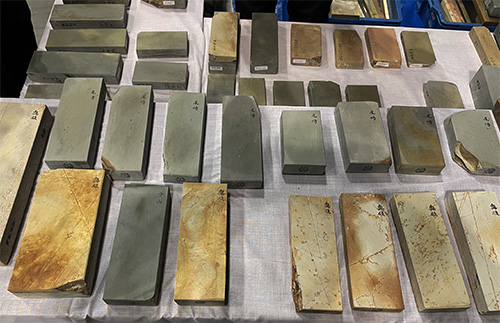


住生活月間中央イベントとしてほっかいどう住宅フェア開催で
いろいろな取材機会があって非常に面白い気付きがあったりする。
関連イベント「削ろう会」会場展示でのひとこま。
削ろう会らしくたくさんの「カンナ」が展示されている。
いちばん上のものは「ヤリカンナ」であります。
現代で一般的な木工道具としては台カンナが一常識的であり、
DIYショップなどで購入することができるけれどカンナにはこういうのもある。
<ヤリカンナ>木の表面を削って滑らかにする大工道具の一つ。
原型は弥生時代から見られる。「かな」と呼ばれていたが16世紀に台鉋が伝わると
見た目から槍鉋と呼ばれた。臼等の曲面を刳りだす作業には今でも用いられる。
・・・ということなんですが、さすがのイベントなので無造作に展示。
説明の方に聞いたらいまでもそこそこの流通ぶりなのだとか。
会場では実演も行われていて興味津々の人だかり。
一般的な台カンナもその刃先が展示即売されていた。
素人としてはこれらの刃先の違いはまったく見分けがつかない。
大工さんが諸国を修行して巡り回るときに在地の棟梁と会って面接試験すると
その持っている大工道具を見られるという。
その道具選択眼をもって棟梁はその大工の技量を鑑定するとされる。
大工と道具との関係というのは日本の「製造業」の核心のありようを
明瞭に浮かび上がらせる事象なのだろうと思います。
今日でも例えばトヨタの生産ラインの詳細には企業の核心的技術力が
凝集して日々鍛錬され、更新もされていっているだろうことはわかる。
そういう鍛錬ぶり、その心がけのようなものが、
大工道具というものにはクッキリと表現されるものなのでしょう。
というところまでは一定知識を持っていたけれど、
今回さらに驚かされたのが「研石」の展示であります。
まぁわが家にも包丁の研石はあるけれど、それを凝視したことはなかった。
ところが説明員の方のお話しでは
「日本刀は研石に合わせてつくる」という驚くべき説明をされていた。
う〜むであります。日本刀というのは欧米人にとっては驚異の兵器。
一刀のもとに首を刎ねることができる攻撃性能は信じがたいと目を瞠った。
明治以降、世界への開国のときに欧米世界が日本に「一目置いた」のには
この先鋭そのものの兵器への恐怖心があったことはあきらか。
「これほどの鋭利な兵器を独自開発できる技術文化圏なんだ・・・」
という心理が与っていたのは間違いないでしょう。
そういう日本刀のさらに技術核心に「研石」との繊細な相性探究があるのだと。
たしかに鋭利さを日々鍛錬していくには研ぎの努力が欠かせない。
先述の大工道具「面接」でもそういう鍛錬ぶりの結果はあきらかに検証可能。
日本刀の繊細さの核心部分に、この日本産の研磨石の組成内容が関与している。
こういう刀を作ってこういう研磨石で日々丹精すると
比類無い「性能を得られる」と日本のものづくりマインド文化は見究めている。
日本は世界でも有数の火山国であり、見究めの眼力があれば
最適な研磨石をその土地土地で探し出していくことが出来る。・・・
一本取られ打ち首にされて、むしろ清々したような気分でうかがっていました。
English version⬇
The Core of Japan’s Manufacturing Spirit: Cutlery and Sharpening Stones
Carpenter’s tools reveal a person’s technical skills. The respect for sharpening is born out of the training of these tools. A world where one is taken for granted. …….
The Hokkaido Housing Fair was held as the central event of the Housing and Living Month.
I had various opportunities to cover the event and came away with some very interesting insights.
This is a shot of the exhibition at the related event, “Let’s Sharpen”.
Many “Kanna” are on display, just like at the “Let’s Sharpen” event.
The top one is a “Yarikanna”.
The bench planer is the most common tool for woodworking today, and can be purchased at DIY shops.
The “Yarikanna” is a tool used for cutting wooden surfaces.
<A carpenter’s tool used to shave the surface of wood to make it smooth.
The prototype can be found from the Yayoi period. It was called “kana,” but when the dai-kanna was introduced in the 16th century, it was called “yari-kanna” because of its appearance.
It was called “yari-kanna” because of its appearance. It is still used today for boring out curved surfaces of mortars and other tools.
The planes were displayed in a random manner at the event.
According to the explanation, they are still in good circulation.
A demonstration was held at the venue, attracting a large crowd of curious visitors.
The tips of ordinary bench-type canners were also on display and for sale.
As a layman, I could not tell the difference between the tips of the blades.
When carpenters travel around the country for training, they meet with local master carpenters for an interview and examination.
The carpenter is said to be able to see the carpenter’s tools that the master carpenter is carrying.
The master carpenter is said to evaluate the carpenter’s skill by his ability to select the right tools.
The relationship between carpenters and tools is an event that clearly reveals the core of Japan’s “manufacturing industry.
The relationship between carpenters and their tools is a phenomenon that clearly reveals the core of Japan’s “manufacturing industry.
Even today, for example, the details of Toyota’s production lines show the core technological capabilities of the company.
I know that even today, for example, in the details of Toyota’s production lines, the company’s core technological capabilities are being developed and renewed on a daily basis.
Such training, such a spirit of training, such a mindset, such a spirit of care, such a spirit of care, such a spirit of care, such a spirit of care.
I think that this kind of training and the spirit of the craftsman is clearly expressed in the carpenter’s tools.
I had a certain amount of knowledge about carpentry tools.
What surprised me even more this time was the display of sharpening stones.
Well, I have sharpening stones for kitchen knives at home, but I had never looked at them closely.
However, according to the explanatory staff, “Japanese swords are made to match the sharpening stones.
The explanation of the museum staff was surprising: “Japanese swords are made in accordance with the sharpening stones.
I was surprised to hear that. The Japanese sword is a marvelous weapon for Westerners.
The offensive capability of being able to cut off a person’s head with a single stroke of the sword was blindingly unbelievable.
After the Meiji era, when Japan opened its doors to the rest of the world, the Western world “took one look” at Japan.
The fear of such a sharp weapon was evident.
The reason for this fear was that Japan was a technological and cultural sphere that could develop such sharp weapons on its own.
The Japanese were undoubtedly influenced by the mentality of “This is a technological culture that can independently develop such a sharp weapon…”.
The search for a delicate match with the sharpening stone is at the heart of the Japanese sword’s technical core.
Indeed, sharpening efforts are indispensable for daily training of sharpness.
The result of such training can be clearly verified by the carpenter’s tool “interview” mentioned above.
The composition of the polishing stones is at the core of the delicacy of Japanese swords.
If you make this kind of sword and use this kind of polishing stone every day, you will get unparalleled “performance”.
Japanese craftsmanship culture has determined that if you make a sword like this and use this kind of polishing stone daily, you can obtain unparalleled performance.
Japan is one of the most volcanic countries in the world.
Japan is one of the most volcanic countries in the world, and if you have a discerning eye, you will be able to find the most suitable abrasive stone in each area. The “Mere Old Man” was beheaded by a single blow.
I felt rather refreshed after being beheaded by a single blow.
Posted on 10月 19th, 2022 by 三木 奎吾
Filed under: 住宅マーケティング, 日本社会・文化研究







コメントを投稿
「※誹謗中傷や、悪意のある書き込み、営利目的などのコメントを防ぐために、投稿された全てのコメントは一時的に保留されますのでご了承ください。」
You must be logged in to post a comment.